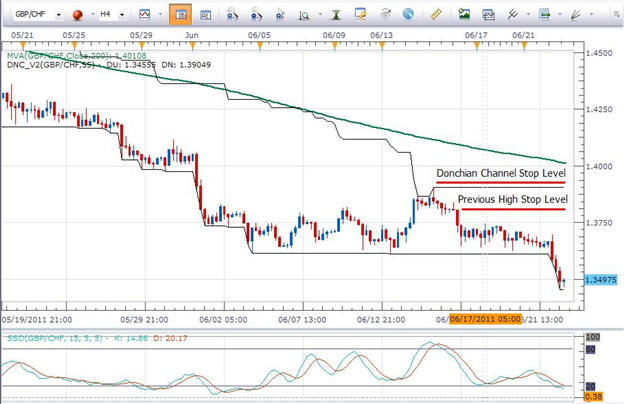A question was emailed in today after the Live Webinar on Multiple Time Frame Analysis was finished.
It is a question that all traders have at some point regarding stop placement. The questioner said when using one strategy the stop should be placed here on this trade but on the same trade using a different strategy, the stop should be in a different place!
Which one is the “right” one??
The chart below will shed light on this very valid point of confusion…

To provide a bit of background… our GBPCHF short position executed as the pair traded below support. In the webinar we discussed “fine tuning” our stop placement on the open position.
One strategy that we teach is using the Donchian Channels for entries and stop placement. The question in the email centered on which was the “correct” stop placement: the Donchian Channel Stop Level or a stop placed above the previous high. (Note the chart above)
The trader asking the question was using the Donchian strategy and I, not using the Donchian Channels in this webinar, had suggested a stop above the previous high. (Either method, by the way, is valid.)
Everything in trading is, no pun intended, a trade off.
On the positive side, using the Donchian Stop Level, a trader can remain in the trade longer by virtue of the deeper stop. The trade has time to develop and it has a lesser likelihood of being stopped out. On the negative side however, the trader has a greater amount at risk and it will be longer before the stop is at breakeven and the trader begins protecting any potential profits.
On the other hand, using the Previous High/Low Stop Level, on the positive side a trader has less at risk by virtue of the shallower stop. Also, the stop will reach breakeven sooner thereby protecting potential profits. On the negative side, by placing the stop in this fashion it is more likely to be triggered potentially closing the trade before it has time to develop and incurring a loss.
Bottom Line: If by the “right” stop placement we mean will the trade be a winner, it will depend on how the market moves the pair after entry and the resultant outcome of the trade. And since we do not know any of that ahead of time, it is impossible to know the right (winning) stop placement ahead of time.
If by the “right’ stop placement we mean placing the stop where it is least likely to be hit, that will depend on the strategy that one is employing. While we cannot know what the market is going to do ahead of time, we CAN know our strategy and how we will implement it ahead of time. So we place our stop based on the strategy that we are using and then use prudent Money Management to insure that if our stop is triggered, our loss will be small and manageable.
There are many, many trading strategies that can be employed when trading FX. Whichever strategy you are using, stick with it. At the very least until you have a clear understanding of what the benefits of the strategy are and using it in your trading becomes second nature. After that, if you choose to “mix and match” from among various strategies, it is certainly your prerogative.
